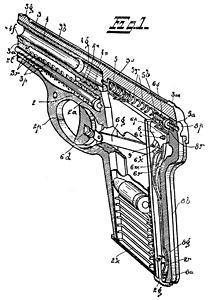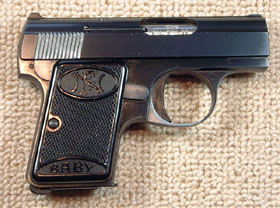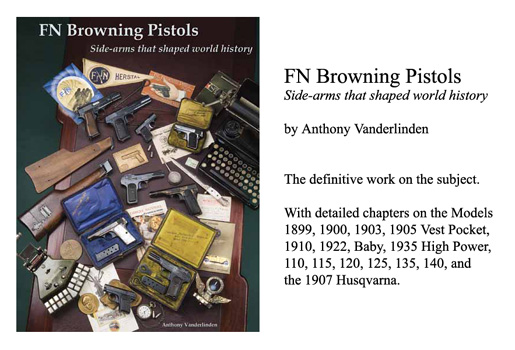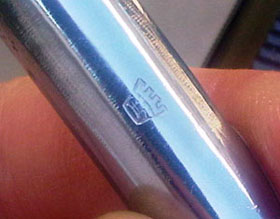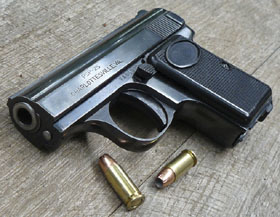 |
|||||||||||||||||||||||||||||||||||||||||||||||||||||||||||||||||||||||||||||||||||||||||||||||||||||||||||||||||||||||||||||||||||||||||||||||||||||||||||||||||||||||||||||||||||||||||||||||||||||||||||||||||||||||||||||||||||||||||||||||||
|
The Baby Browning Historical Perspective
In regard to the origins of the Baby Browning design, Vanderlinden, in his book FN Browning Pistols: Side-Arms that Shaped World History, states: “...there is no evidence to indicate that FN was seeking to develop a new pocket pistol...,” and he concludes that DieudonnÚ Saive acted entirely on his own initiative in designing the Baby. I’d be very curious to know if Saive ever had the opportunity to discuss designing a new, smaller .25 caliber pistol with John M. Browning. The name “Baby” was a nickname that was sometimes applied to the 1906 FN Browning, which was the first 6.35mm pistol ever manufactured, but “Baby” was never an official designation for the gun. However, it was the perfect name for Saive’s diminutive new pistol. The new Baby Browning was nearly a half-inch shorter than the FN Model 1906 and weighed four ounces less. The fact that the new Baby was called a Browning might seem a bit surprising, since John M. Browning had no part in its design. However, every previous pistol manufactured by FN had been a Browning design, and every one had been called “le pistolet Browning,” followed by a model number based on the date of its origin, so it seemed perfectly natural to FN personnel to call the new pistol a Browning as well. By this time, “Browning” had become a generic term for the ammunition used in the guns. According to Anthony Vanderlinden, Browning had an agreement with FN as early as 1907 allowing them to use his name as a trademark Fabrique Nationale Production
Saive retained Browning’s method of attaching the barrel to the frame, but otherwise his design was based on the Walther Model 9, and was clearly intended to compete with it. The excellent stirrup-shaped Browning connector and the grip safety of the Model 1906 were eliminated in order to reduce size and weight. Like the Walther, the Baby Browning has an external connector/disconnector that runs under the right-side grip plate, a thumb-operated manual safety lever than runs under the left-side grip plate, and a cocking indicator at the rear of the frame. The manual safety locks the sear, but the Walther’s safety is engaged when the lever is down, whereas the Baby Browning’s safety is engaged in the up position and also locks the slide. Both guns have a magazine safety to lock the sear when the magazine is removed. The Baby Browning magazine safety also prevents the magazine from being inserted if the trigger is being pulled, and FN literature claimed that if the gun were dropped the magazine safety would be jarred backward, locking the sear and preventing an accidental discharge. The complex latch mechanism at the rear of the Walther was not necessary on the Baby Browning because takedown is accomplished via the removeable barrel. During the first decade of its production the Baby Browning was offered only with a blued finish. No nickle, engraved, or luxury versions were advertised, though custom work could always be had for a price. The grips are made of a black checkered plastic material with the FN monogram in an oval at the top and the word “Baby” at the bottom. The left side slide legend is on two lines in all-capital sans-serif characters as follows: FABRIQUE NATIONALE D’ARMES DE GUERRE HERSTAL BELGIQUE Possibly as early as 1962 the slide legend was changed to fit on three lines: FABRIQUE NATIONALE D’ARMES DE GUERRE In 1972 the slide legend was changed to read simply FABRIQUE NATIONALE The serial number is on the left side of the frame, above and slightly behind the trigger. Serial numbers began with 1. The barrel is marked CAL.6m/m35., visible in the ejection port of the slide, and the barrel is stamped with the standard Liege proof marks. Belgian inspector and smokeless powder proofs are also stamped on the right side of the slide and frame.
According to Vanderlinden, the Germans completed only 129 Baby Browning pistols during the occupation in 1940. This was prior to the introduction of the German Waffenamt acceptance stamps in Belgium, so these pistols have no German markings. Extrapolating from Vanderlinden’s data, the serial number range for these German-made Baby Brownings should be 50148 through 50276. Production of the Baby Browning did not resume again until after the war in 1946. According to Vanderlinden, more than 10,000 pistols were made in 1946, but production must have declined thereafter, because in 1953 only 1,374 were made. In 1953 the Baby Browning became available in a nickle-chrome finish as well as with an aluminum frame (called Duraluminum by FN). U.S. import guns with the aluminum frame were available only with the chrome finish slide, but FN also sold them with a blued slide in the rest of the world. A fully engraved version became available about this time, marketed as the “Renaissance.” Browning Arms Company The Browning Arms Company formed an agreement with FN to import their pistols into the United States in 1953. Consequently, production of the Baby Browning rose nearly tenfold to 13,313 in 1954. The American market was huge, and production remained high as long as the guns continued to be imported into the U.S. Guns imported into the United States were identical to those sold in the rest of the world, except the grips had the word BROWNING in the oval at the top, there was no “Baby” designation at the bottom of the grips, and the slide inscription was in all-capital italic sans-serif characters as follows: BROWNING ARMS COMPANY or: BROWNING ARMS COMPANY__ST. LOUIS, MISSOURI
In 1977 FN bought the Browning Arms Company and all its trademarks, which it still owns to this day. After 1977 all Baby Brownings used grips with the Browning name at the top--the FN monogram and the word “Baby” were no longer used. Importation of the Baby Browning into the U.S. ceased after the 1968 Gun Control Act went into effect. With the loss of the U.S. market, production plummeted by about 95% in a single year. MAB Production
PSP and PSA Production There was an hiatus in the production of the Baby Browning between 1983 and 1986.
PSP quickly realized they could not legally manufacture or sell firearms in Canada. However, they had a subsidiary plant in Charlottesville, Virginia, and they were able to move production of frames and barrels to the United States, while continuing to produce slides and other parts for the gun in the Aurora, Ontario plant. Precision Small Parts manufactured the Baby Browning as the PSP-25 from 1987 through 1995. Relatively small numbers were made for FN with the FABRIQUE NATIONALE slide legend and BROWNING on the grips. Guns destined for sale in the U.S. are marked on the left side of the slide in all-capital sans-serif characters as follows: PSP-25 Grips are of checkered plastic with a blank oval at the top. Some guns were distributed by Michael Kassnar of KBI Products and have the word Kassnar in the oval at the top of the grips, but the slides are still marked PSP-25.
Precision Small Parts went into receivership circa 1988-1990, and the company was purchased and recapitalized in 1991 by a U.S. investor, Lenn Kristal, in collaboration with two Canadian investors. Lenn Kristal became Chairman of the Board. In 1997 the arms-making portion of Precision Small Parts was spun off as Precision Small Arms (PSA), with Lenn Kristal as president. The new company eventually relocated to Aspen, Colorado. However, production of the Baby Browning was halted between 2000 and 2003. By 2006 the manufacturing process had been reengineered to use state-of-the-art computer numeric controlled (CNC) technology. Early PSA guns are marked on the left side of the slide in all-capital sans-serif characters as follows: PSA-25 Grips are of checkered plastic with the PSA monogram in an oval at the top. Later PSA guns are marked on the left side of the slide in all-capital sans-serif characters as follows: PSA-25 Early guns made in Colorado have serial numbers beginning with 00C, the first number being 00C0000001. A few of these guns appear to have been made with the FABRIQUE NATIONALE slide legend; these do not say MADE IN BELGIUM and do not have Belgian proof marks. Current production PSA guns are available in 20 different versions with a multitude of options, including standard blued steel, nickel plate, stainless steel, nitrate coated stainless, aluminum frame featherweight, 18 or 24 carat gold plate, and various levels of engraving and gold inlay. Standard grips are checkered nylon impregnated black polymer with the PSA monogram in an oval at the top. The Featherweight version has checkered grips milled from billet aluminum with the PSA monogram in an oval at the top and the word “Baby” at the bottom, much like the original FN grips.
* I welcome photographs of old or new Baby Browning pistols, and would be grateful for any information regarding serial number sequences. Email Ed Buffaloe.
|
|||||||||||||||||||||||||||||||||||||||||||||||||||||||||||||||||||||||||||||||||||||||||||||||||||||||||||||||||||||||||||||||||||||||||||||||||||||||||||||||||||||||||||||||||||||||||||||||||||||||||||||||||||||||||||||||||||||||||||||||||
|
Copyright 2011 by Ed Buffaloe. All rights reserved. |
|||||||||||||||||||||||||||||||||||||||||||||||||||||||||||||||||||||||||||||||||||||||||||||||||||||||||||||||||||||||||||||||||||||||||||||||||||||||||||||||||||||||||||||||||||||||||||||||||||||||||||||||||||||||||||||||||||||||||||||||||
|
|
|||||||||||||||||||||||||||||||||||||||||||||||||||||||||||||||||||||||||||||||||||||||||||||||||||||||||||||||||||||||||||||||||||||||||||||||||||||||||||||||||||||||||||||||||||||||||||||||||||||||||||||||||||||||||||||||||||||||||||||||||
